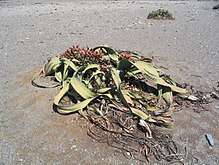Welwitschiaceae
Welwitschiaceae is a family of plants of the order Gnetales with one living species, Welwitschia mirabilis, found in southwestern Africa. Three fossil species have been recovered from the Crato Formation – late Aptian (Lower Cretaceous) strata located in the Araripe Basin in northeastern Brazil.[1]
| Welwitschiaceae | |
|---|---|
 | |
| Welwitschia mirabilis | |
| Scientific classification | |
| Kingdom: | Plantae |
| Clade: | Tracheophytes |
| Division: | Gnetophyta |
| Class: | Gnetopsida |
| Order: | Welwitschiales |
| Family: | Welwitschiaceae Markgr. |
Taxonomy
German naturalist Friedrich Markgraf coined the name Welwitschiaceae in 1926, which appeared in Die Natürlichen Pflanzenfamilien.
Most recent systems place the Welwitschiaceae in the gymnosperm order Gnetales.[2] This order is most closely related to the order Pinales, which includes pines, spruces, larches and firs.[3] Genetic analyses indicate that the Gnetales arose from within the conifer group, and any morphological similarities between angiosperms and Gnetales have evolved separately.[4] The ancestors of the extant gymnosperm orders—Gnetales, Coniferales, Cycadales and Ginkgoales—arose during the Late Paleozoic, and became the dominant component of the Late Permian and Mesozoic flora.[5]
Living species
The family contains a single genus and single extant species, Welwitschia mirabilis, which lives in the Kaokoveld Desert of Angola and Namibia in southwestern Africa.[6]
Fossil species
Fossil evidence indicates that members of the Welwitschiaceae were present in South America during the Early Cretaceous (Mesozoic era).[1] Priscowelwitschia austroamericana (initially named Welwitschiella but illegitimate due to the daisy genus Welwitschiella)[7] is a fossil taxon referring to some seedlings with cotyledon leaves. These have many features in common with Welwitschia seedlings.[1] Welwitschiophyllum brasiliense is a taxon known from thick triangular to linear leaves that range from 8.9 to 70 cm long and 2.8–5 cm wide.[1] Welwitschiostrobus murili is a fossil taxon known from some cones that resemble the living Welwitschia, but are longer and thinner.[1]
Jacobson and Lester[8] suggest that these early habitats were more mesic than the current desert conditions, and that the present fragmented and isolated population distribution could be attributed to aridification during the Paleogene, Neogene, and Quaternary, which restricted the plants to locales providing sufficient water for their needs.
References
- Dilcher, David L.; Bernardes-De-Oliveira, Mary E.; Pons, Denise; Lott, Terry A. (2005). "Welwitschiaceae from the Lower Cretaceous of northeastern Brazil". American Journal of Botany. 92 (8): 1294–1310. doi:10.3732/ajb.92.8.1294. PMID 21646150.
- Stevens, P. F. (2001 onwards). Angiosperm Phylogeny Website. Version 9, June 2008 http://www.mobot.org/MOBOT/research/APWeb/
- Christenhusz, M.J.M.; Reveal, J.L.; Farjon, A.; Gardner, M.F.; Mill, R.R.; Chase, M.W. (2011). "A new classification and linear sequence of extant gymnosperms" (PDF). Phytotaxa. 19: 55–70. doi:10.11646/phytotaxa.19.1.3.
- Chaw S-M., C.L. Parkinson, Y. Cheng, T.M. Vincent and J. D. Palmer (2000) Seed plant phylogeny inferred from all three plant genomes: Monophyly of extant gymnosperms and origin of Gnetales from conifers Proceedings of the National Academy of Sciences of the United States of America 97:4086–4091
- Wang, Z-Q (2004). "A new Permian Gnetalean cone fossil as evidence for supporting molecular phylogeny". Annals of Botany. 94 (2): 281–288. doi:10.1093/aob/mch138. PMC 4242163. PMID 15229124.
- Bhatnagar, S. P.; Moitra, Alok (1996). Gymnosperms. p. 373. ISBN 9788122407921.
- Dilcher, David L.; Bernardes-De-Oliveira, Mary E.; Pons, Denise; Lott, Terry A. (2005). "Welwitschiaceae from the Lower Cretaceous of northeastern Brazil". American Journal of Botany – Erratum. 92 (12): 1957.
- Jacobson, K.M.; Lester, E. (2003). "A first assessment of genetic variation in Welwitschia mirabilis Hook". Journal of Heredity. 94 (3): 212–217. CiteSeerX 10.1.1.495.1358. doi:10.1093/jhered/esg051. PMID 12816961.